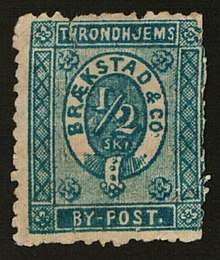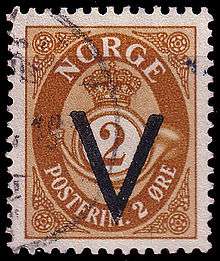Postage stamps and postal history of Norway

The postal system of Norway dates from 1647, when Christian IV of Denmark-Norway granted a concession to a private company who established the Postvesenet (now Posten Norge). The Postvesenet primarily provided a way for various parts of the country to communicate with the central government in Christiania (now Oslo). Although Norway came under rule of the Swedish king in 1815,[1] the postal service remained independent of the Swedish post, and continued to gradually established routes throughout the country.
History
Christian IV granted the postal concession for Norway to Henrik Morian on 17 January 1647 and Morian became the first Norwegian postmaster, followed by his wife Anna who was postmaster from 1648 to 1653. The first route was by sea from Christiania to Copenhagen. Other sea routes, including the ones to Kristiansand, Starvanger, Bergen, and Trondheim followed. Originally, all mail was consolidated in Christiania before being sent out. The sea routes utilized merchant shipping, but land routes were slower to develop, with the post being passed from farmstead to farmstead. Inentives for postal-route farmers included exemptions from county road work and military service, and in some cases reduction in taxes. The postal routes delivered the mail to the government offices, and there was no local mail delivery, so gradually private local posts grew up in the larger cities and towns.
In 1719, the private concession was terminated and the Danish-Norwegian state took over the national postal service as a state monopoly; however, the local city posts remained private.[2]
The first postal marking was a cancellation introduced at Oslo in 1845. The first postage stamp was issued in 1855, and depicted the Coat of arms of Norway. At the same time, numeral cancellations were used to indicate the post office using them, the numbers eventually reaching 383.
Posthorn stamps
In 1871, Norway introduced its first stamp with a posthorn design; stamps of this type, with periodic redesigns, have been in use ever since.
Local posts

Local posts, both formal and informal, originally grew up to distribute the non-official mail brought by the Postvesenet, and soon included messenger services within towns.
In 1888, there were fourteen private local posts in operation in Norway. Following commercial concerns about this patchwork system of mail delivery, the Norwegian government conducted a review of the effectiveness and trustworthiness of local post deliveries. The postmaster asked local governments, where such servives operated, for comments, as well as conducting inspections. As a result, most were ordered shutdown immediately, a couple were permitted to remain until the Postvesenet established local deliveries. By the mid 1890s all of the local city posts were gone except for the one in Trondheim, the Trondhjems By-Post. It continued until 1913.[3]
Spelling reform
In 1918, the government moved to reform Norwegian orthography, most notably giving a Norwegian spelling to foreign loan words. For example, "station" became stasjon, which along with changes in the names of some towns, required changing postmarks. At this time the postvæsen (postal service) became the postvesen.[2]
World War II

When Norway was invaded by Nazi Germany in 1940, a British/French expeditionary force in northern Norway established field post offices that operated until the troops withdrew to England in June 1940. While the new collaborationist government in Norway issued its own stamps, the government-in-exile, based in London, issued stamps for the use of the Royal Norwegian Navy and the merchant marine. These stamps were also used in Jan Mayen island, and, from February 1945, in a Norwegian post office established in Stockholm.
Mail volume increased significantly during the German occupation, as travel was restricted, but also because rural families would send food to their city relatives using parcel post. Postal workers suffered additional dangers during the occupation, as twenty-four postal ships were sunk along the Norwegian coast during the war, and forty-nine postal officials were killed in the course of their duties.[4]
Notes and references
- ↑ The Danish king gave up Norway under the 1814 Treaty of Kiel which ended Danish support of France in the Napoleonic Wars. von Jenssen-Tusch, Georg Friedrich (1852). Zur Regierungsgeschichte Friedrich VI. Königs von Dänemark, Herzogs von Schleswig, Holstein und Lauenburg (in German). 2. Kiel: Schröder Verlag. pp. 165–166. After a brief Swedish–Norwegian War, Norway enterred into personal union under Charles XIII of Sweden. Nansen, Fridtjof (1905). Norway and the Union with Sweden. London: Macmillan.
- 1 2 Løhre, Arvids (2008). "Postens logi (Del 1). Fra Kongens merke til internasjonal kosnsernprofil" (PDF). Budstikka (in Norwegian). Vol. 13 no. 4. Archived (PDF) from the original on 22 April 2018.
- ↑ Brunstrom, Christer (14 December 2015). "Private post served Trondheim, Norway, for 48 years". Linn's Stamp News. Archived from the original on 31 October 2016.
- ↑ Eriksen, E. B. (1945). Utdrag av nordnorske posthistoriske blad av båtposttidens saga (in Norwegian). Stockholm: Fahlcrantz.
Sources
- Scott catalog
- Wellsted, Rossiter, and Flower, The Stamp Atlas (Macdonald, 1986, ISBN 0-8160-1346-2) p. 99
Further reading
- Gjelsvik, Tore. Norway Number One: a new handbook. Oslo/Bergen: Norsk Filatelistforbund; Filatellistisk Forlag AS, 2000 ISBN 8290272715 128p.
- Håndbok over Norges frimerker, 1855-1955. Oslo: Norsk filatelistforbund. Vol. 1: 1855-1888 (1963). Vol. 2: 1886-1955 (1966).
- Johannessen, Finn Erhard and Lars Thue. Alltid Underveis: Postverkets historie gjennom 350 ar. Oslo: Postverkets; Elanders Forlag, 1997 ISBN 8290545657 Vol. 1: 1647-1920; Vol. 2: 1920-1997
- Oslo Filatelistklubb. Katalog over Norges frimerker: "Norgeskatalogen" = Catalogue of the postage stamps of Norway.
- Wise, Ernest H. Stamps of Denmark, Iceland, and Norway: the earlier issues. London: Heinemann, 1975 ISBN 0434922714 214p.
External links
| Wikimedia Commons has media related to Stamps of Norway. |